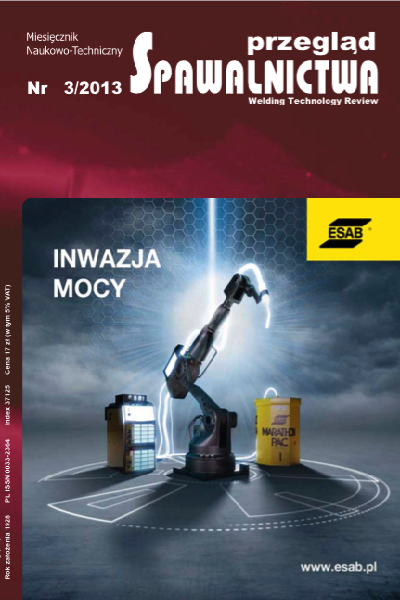Pomiar i określenie ugięcia powierzchni jeziorka spawalniczego oraz głębokości wtopienia spoiny w pulsacyjnym spawaniu MIG/MAG
Main Article Content
Abstract
Powierzchnia jeziorka spawalniczego może zawierać dane wystarczające do wyznaczenia głębokości wtopienia spoiny. W badaniach użyto szybkostrzelnego systemu wizyjnego z kamerą do rejestracji obrazu powierzchni jeziorka spawalniczego podczas spawania łukowego elektrodą topliwą w osłonie gazu (GMAW lub MIG/MAG). Aby wyliczyć ugięcie ciśnieniem łuku powierzchni jeziorka spawalniczego z uzyskanego obrazu zaproponowano procedurę kalibracji, która umożliwiłaby określenie parametrów do przeprowadzenia obliczeń. Ustalono parametry spawania do wykonania serii eksperymentów spawania prądem impulsowym metodą MIG/MAG. Modelowanie z użyciem danych eksperymentalnych wykazało, że zmiana ugięcia powierzchni jeziorka spawalniczego w fazie prądu impulsu może być wykorzystana do przewidywania głębokości wtopienia spoiny z wystarczającą dokładnością. Bezpośrednie zastosowanie tych wyników komplikuje jednak konieczność wykorzystania systemu wizyjnego. Aby znaleźć metodę, którą można zastosować do monitorowania wtopienia spoiny przy użyciu sygnałów łatwych do zmierzenia w warunkach produkcyjnych, przeanalizowano potencjalny związek pomiędzy zmianą ugięcia powierzchni jeziorka spawalniczego a napięciem łuku. Analiza wykazała, że zmiana napięcia łuku w fazie prądu impulsu może precyzyjnie odzwierciedlać zmianę wartości ugięcia powierzchni jeziorka w fazie prądu impulsu. W związku z tym, proponuje się określanie wtopienia spoiny ze zmiany napięcia łuku w fazie prądu impulsu. Wyniki modelowania pokazują, że zmiana napięcia łuku w fazie prądu impulsu może umożliwiać dokładne przewidywanie głębokości wtopienia podczas spawania impulsowego MIG/MAG.
Measurement and estimation of weld pool surface depth and weld penetration in pulsed gas metal arc welding
Abstract
The weld pool surface may contain sufficient information to determine weld penetration. In this study, a high-speed camera-based vision system was used to ima- ge the weld pool surface during gas metal arc welding (GMAW).To calculate the depth of the weld pool surface from the acquired image, a calibration procedure is proposed to determine the parameters in the calculation equation. Welding parameters were designed to conduct a series of pulsed GMAW (GMAW-P) experiments. Modeling using experimental data shows that the change of the weld pool surface depth during the peak current period can predict the depth of the weld penetration with adequate accuracy. However, a direct application of this result is complicated by the need for a vision system. To find a method that can be used to monitor the weld penetration using signals that are easily measurable in manufacturing facilities, a possible relationship between a change in weld pool surface depth and a change in arc voltage was analyzed. The analysis suggested that the change in arc voltage during the peak current period may reflect accurately the change in weld pool surface depth during the peak current period. As a result, it is proposed that the depth of the weld penetration be determined from the change in arc voltage during the peak current period. The modeling result shows that the change in arc voltage during peak current can indeed provide an accurate prediction for the depth of the weld penetration during GMAW-P.
Downloads
Article Details
Creative Commons CC BY 4.0 https://creativecommons.org/licenses/by/4.0/
Welding Technology Review (WTR) articles are published open access under a CC BY licence (Creative Commons Attribution 4.0 International licence). The CC BY licence is the most open licence available and considered the industry 'gold standard' for open access; it is also preferred by many funders. This licence allows readers to copy and redistribute the material in any medium or format, and to alter, transform, or build upon the material, including for commercial use, providing the original author is credited.
References
Kim, Y, S,, and Eagar, T, W, 1993, Analysis of metal transfer in gas metal arc welding, Welding Journal 72: s. 269-278.
Esser, W, G,, and van Gompel, M, R, M, 1984, Arc control with pulsed GMA welding, Welding Journal 63: s. 26-32.
Ueguri, S,, Hara, H,, and Komura, H, 1985, Study of metal transfer in pulsed GMA welding, Welding Journal 64:
s. 242-250.
Allum, C, J, 1985, Welding technology data: pulsed MIG welding, Welding and Metal Fabrication 53: s. 24-30.
Kovacevic, R,, Zhang, Y, M,, and Ruan, S, 1995, Sensing and control of weld pool geometry for automated GTA welding,
ASME Journal of Engineering for Industry 117(2): 210-222.
Chin, B, A,, Madsen, n, H,, and Goodling, J, S, 1983, Infrared thermography for sensing the arc welding process, Welding
Journal 62: s. 227-234.
Madigan, R, B,, Renwich, R, J,, Farson, D, F,, and et al, 1986, Computer-based control of full-penetration TIG welding using pool oscillation sensing, Proceedings of First Interna- tional Conference on Computer Technology in Welding, The Welding Institute, London.
Xiao, Y, H, 1992, Weld pool oscillation during gas tungsten arc welding, Ph,D, dissertation, Delft, The netherlands, Delft University of Technology.
Wang, Q, L, 1991, Real-time full-penetration control with arc sensor in the TIG welding of Al alloy, Proceedings of the International Conference on Joining/Welding 2000, IIW, the netherlands.
Mnich, C,, Al-Bayat, F,, Debrunner, C, and et al, 2004, In situ weld pool measurement using stereovision, ASME, Proceedings 2004, Japan USA Symposium on Flexible Automation, Denver, Colorado.
